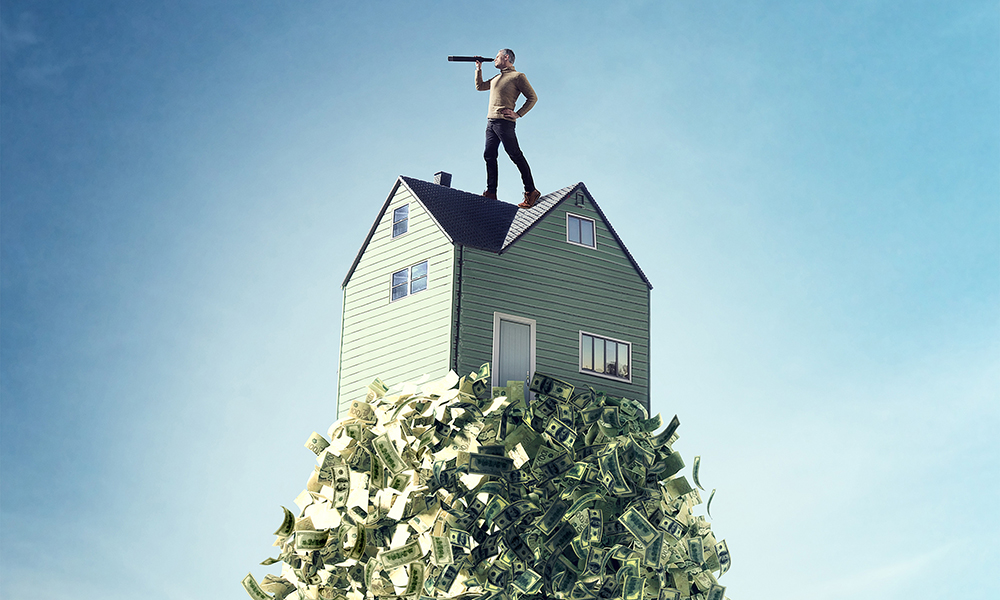
去年年初,,美國(guó)炒房客退出市場(chǎng);據(jù)Redfin統(tǒng)計(jì),,炒房客的購(gòu)房數(shù)量驟減了約50%,,與現(xiàn)房銷量相差無幾,據(jù)我們所知,,現(xiàn)房銷量降至近30年來的最低水平,。
這與他們?cè)谝咔閹淼姆康禺a(chǎn)市場(chǎng)繁重期間的活動(dòng)有所不同。當(dāng)時(shí),,炒房客購(gòu)房數(shù)量翻了一番以上,。由于抵押貸款利率史上最低且遠(yuǎn)程辦公流行,因此所有人都在買房。但隨著抵押貸款利率飆升,,一切都發(fā)生了改變,,而且在有些地區(qū)房?jī)r(jià)和房租下跌,導(dǎo)致炒房客的利潤(rùn)大幅縮水,。別忘了借款成本同樣大幅上漲,。
現(xiàn)在,炒房客們又回來了,。Redfin表示:“炒房客購(gòu)房數(shù)量在近兩年來首次實(shí)現(xiàn)增長(zhǎng),,盡管增長(zhǎng)幅度較小?!痹谧钚掳l(fā)布的一份分析報(bào)告中,,Redfin發(fā)現(xiàn)炒房客在第一季度購(gòu)買了44,000套住房,比去年同期增長(zhǎng)了0.5個(gè)百分點(diǎn),。(Redfin對(duì)炒房客的定義是“購(gòu)買住宅房地產(chǎn)的任何機(jī)構(gòu)或企業(yè)”,。)
Redfin表示,今年第一季度,,炒房客幾乎購(gòu)買了19%的售出房屋,,相當(dāng)于他們買下了接近五分之一的住房。分析報(bào)告稱,,雖然房屋數(shù)量少于以前和疫情期間的水平,,但卻是近兩年來的最高比例。
Redfin認(rèn)為,,炒房客回歸的原因是,,“隨著房?jī)r(jià)和房租恢復(fù)上漲,以及抵押貸款利率上漲帶來的初步?jīng)_擊消失”,,投資者正在“松開剎車”,,紛紛進(jìn)入市場(chǎng)。盡管如此,,炒房客的獲利也超過了一年前,。今年3月,炒房客出售的普通住宅回報(bào)率超過55%,,利潤(rùn)接近175,000美元,。去年,在通常情況下,,炒房客賣房的價(jià)格,,比其購(gòu)房?jī)r(jià)格高出超過146,000美元,漲幅超過了46%,。很少有炒房客賠錢賣房,。
Redfin的分析發(fā)現(xiàn),,炒房客正在購(gòu)買比以前價(jià)格更貴的房子,而且他們購(gòu)買的美國(guó)最經(jīng)濟(jì)實(shí)惠的住宅所占的比例也創(chuàng)下歷史紀(jì)錄,。分析報(bào)告說道:“今年第一季度,,炒房客購(gòu)買的普通住房?jī)r(jià)格為464,560美元,同比上漲了9.2%,。第一季度,,炒房客購(gòu)買的住房?jī)r(jià)值達(dá)到313億美元,同比上漲6.6%,。”
需要注意的是,,雖然在第一季度,,炒房客購(gòu)買的更昂貴的住宅數(shù)量增長(zhǎng)最快,但低價(jià)住宅依舊占更大比例,。因此據(jù)Redfin統(tǒng)計(jì),,在第一季度炒房客購(gòu)買的房屋中,低價(jià)住宅占47.5%,,而高價(jià)住宅的比例為28.5%,。炒房客購(gòu)買的高價(jià)住宅增加的主要原因是加州的炒房客增多。在舊金山和圣地亞哥,,第一季度售出的住宅有超過23%被炒房客買下,,是除了佛羅里達(dá)州的邁阿密和杰克遜維爾以外,比例最高的城市,。
但炒房客在舊金山的獲利與費(fèi)城等地不可同日而語(yǔ),;在舊金山,炒房客出售普通住宅的售價(jià),,比購(gòu)買價(jià)上漲了近29%,,但在費(fèi)城,炒房客出售普通住宅的售價(jià),,比購(gòu)買價(jià)高出超過136%,。
雖然炒房客依舊會(huì)購(gòu)買獨(dú)棟住宅和多戶住宅,今年第一季度,,炒房客購(gòu)買的獨(dú)棟住宅增長(zhǎng)了近4%,,但他們購(gòu)買的聯(lián)排房屋、自有公寓和公寓樓等多戶住宅的數(shù)量卻有所減少,。由于對(duì)獨(dú)棟住宅(例如小戶型的住宅)的理想化,,美國(guó)人傾向于購(gòu)買獨(dú)棟住宅。據(jù)Redfin統(tǒng)計(jì),,第一季度,,獨(dú)棟住宅在炒房客購(gòu)買的房屋中占比接近69%,,而且比例還在不斷擴(kuò)大。
分析發(fā)現(xiàn):“美國(guó)第一季度售出的獨(dú)棟住宅,,有18.4%被炒房客買下,,這個(gè)比例為自2022年年中以來的新高?!迸c此同時(shí),,炒房客購(gòu)買的其他類型地產(chǎn)的比例同比下降,多戶住宅下降到31.9%,,自有公寓/合作公寓和聯(lián)排房屋的比例下降至18.1%,。”
然而,,在新澤西州的一位Redfin房屋中介說道:“炒房客與普通購(gòu)房人之間的權(quán)力平衡正在發(fā)生變化,。”這位房屋中介表示,,當(dāng)發(fā)生對(duì)一套房屋的競(jìng)價(jià)大戰(zhàn)時(shí),,賣房人可能傾向于選擇實(shí)際住在當(dāng)?shù)氐馁?gòu)房人,而且在某些情況下,,個(gè)人可能愿意比炒房客支付更高首付,。
我們很少聽說這種情況。但正如《財(cái)富》雜志之前的報(bào)道所說,,大多數(shù)人估計(jì),,黑石集團(tuán)(Blackstone)和Invitation Homes等機(jī)構(gòu)投資者的所有權(quán),在獨(dú)棟住宅租賃中的占比不到5%,,在所有獨(dú)棟住宅中的占比不到1%,。因此美國(guó)的房地產(chǎn)市場(chǎng)不景氣,很難歸咎于機(jī)構(gòu)投資者,。然而在有些市場(chǎng)情況卻截然不同,,例如在亞特蘭大,機(jī)構(gòu)投資者持有超過4%的獨(dú)棟住宅,,這可能是房屋成本更高的原因之一,。
關(guān)于房地產(chǎn)市場(chǎng)存在炒房客的話題層出不窮,但我們可以確認(rèn)的是,,在經(jīng)過近兩年的蟄伏之后,,他們又卷土重來,在房地產(chǎn)市場(chǎng)全面陷入停滯期間,,炒房客的購(gòu)房數(shù)量曾短暫下滑,,但現(xiàn)在開始增長(zhǎng)。當(dāng)然這與疫情帶來的房地產(chǎn)市場(chǎng)繁榮期間的情況,,仍不能相提并論,。(財(cái)富中文網(wǎng))
翻譯:劉進(jìn)龍
審校:汪皓
去年年初,,美國(guó)炒房客退出市場(chǎng);據(jù)Redfin統(tǒng)計(jì),,炒房客的購(gòu)房數(shù)量驟減了約50%,,與現(xiàn)房銷量相差無幾,據(jù)我們所知,,現(xiàn)房銷量降至近30年來的最低水平,。
這與他們?cè)谝咔閹淼姆康禺a(chǎn)市場(chǎng)繁重期間的活動(dòng)有所不同。當(dāng)時(shí),,炒房客購(gòu)房數(shù)量翻了一番以上,。由于抵押貸款利率史上最低且遠(yuǎn)程辦公流行,因此所有人都在買房,。但隨著抵押貸款利率飆升,,一切都發(fā)生了改變,而且在有些地區(qū)房?jī)r(jià)和房租下跌,,導(dǎo)致炒房客的利潤(rùn)大幅縮水。別忘了借款成本同樣大幅上漲,。
現(xiàn)在,,炒房客們又回來了。Redfin表示:“炒房客購(gòu)房數(shù)量在近兩年來首次實(shí)現(xiàn)增長(zhǎng),,盡管增長(zhǎng)幅度較小,。”在最新發(fā)布的一份分析報(bào)告中,,Redfin發(fā)現(xiàn)炒房客在第一季度購(gòu)買了44,000套住房,,比去年同期增長(zhǎng)了0.5個(gè)百分點(diǎn)。(Redfin對(duì)炒房客的定義是“購(gòu)買住宅房地產(chǎn)的任何機(jī)構(gòu)或企業(yè)”,。)
Redfin表示,,今年第一季度,炒房客幾乎購(gòu)買了19%的售出房屋,,相當(dāng)于他們買下了接近五分之一的住房,。分析報(bào)告稱,雖然房屋數(shù)量少于以前和疫情期間的水平,,但卻是近兩年來的最高比例,。
Redfin認(rèn)為,炒房客回歸的原因是,,“隨著房?jī)r(jià)和房租恢復(fù)上漲,,以及抵押貸款利率上漲帶來的初步?jīng)_擊消失”,投資者正在“松開剎車”,,紛紛進(jìn)入市場(chǎng),。盡管如此,,炒房客的獲利也超過了一年前。今年3月,,炒房客出售的普通住宅回報(bào)率超過55%,,利潤(rùn)接近175,000美元。去年,,在通常情況下,,炒房客賣房的價(jià)格,比其購(gòu)房?jī)r(jià)格高出超過146,000美元,,漲幅超過了46%,。很少有炒房客賠錢賣房。
Redfin的分析發(fā)現(xiàn),,炒房客正在購(gòu)買比以前價(jià)格更貴的房子,,而且他們購(gòu)買的美國(guó)最經(jīng)濟(jì)實(shí)惠的住宅所占的比例也創(chuàng)下歷史紀(jì)錄。分析報(bào)告說道:“今年第一季度,,炒房客購(gòu)買的普通住房?jī)r(jià)格為464,560美元,,同比上漲了9.2%。第一季度,,炒房客購(gòu)買的住房?jī)r(jià)值達(dá)到313億美元,,同比上漲6.6%?!?/p>
需要注意的是,,雖然在第一季度,炒房客購(gòu)買的更昂貴的住宅數(shù)量增長(zhǎng)最快,,但低價(jià)住宅依舊占更大比例,。因此據(jù)Redfin統(tǒng)計(jì),在第一季度炒房客購(gòu)買的房屋中,,低價(jià)住宅占47.5%,,而高價(jià)住宅的比例為28.5%。炒房客購(gòu)買的高價(jià)住宅增加的主要原因是加州的炒房客增多,。在舊金山和圣地亞哥,,第一季度售出的住宅有超過23%被炒房客買下,是除了佛羅里達(dá)州的邁阿密和杰克遜維爾以外,,比例最高的城市,。
但炒房客在舊金山的獲利與費(fèi)城等地不可同日而語(yǔ);在舊金山,,炒房客出售普通住宅的售價(jià),,比購(gòu)買價(jià)上漲了近29%,但在費(fèi)城,,炒房客出售普通住宅的售價(jià),,比購(gòu)買價(jià)高出超過136%,。
雖然炒房客依舊會(huì)購(gòu)買獨(dú)棟住宅和多戶住宅,今年第一季度,,炒房客購(gòu)買的獨(dú)棟住宅增長(zhǎng)了近4%,,但他們購(gòu)買的聯(lián)排房屋、自有公寓和公寓樓等多戶住宅的數(shù)量卻有所減少,。由于對(duì)獨(dú)棟住宅(例如小戶型的住宅)的理想化,,美國(guó)人傾向于購(gòu)買獨(dú)棟住宅。據(jù)Redfin統(tǒng)計(jì),,第一季度,,獨(dú)棟住宅在炒房客購(gòu)買的房屋中占比接近69%,而且比例還在不斷擴(kuò)大,。
分析發(fā)現(xiàn):“美國(guó)第一季度售出的獨(dú)棟住宅,,有18.4%被炒房客買下,這個(gè)比例為自2022年年中以來的新高,?!迸c此同時(shí),炒房客購(gòu)買的其他類型地產(chǎn)的比例同比下降,,多戶住宅下降到31.9%,,自有公寓/合作公寓和聯(lián)排房屋的比例下降至18.1%?!?/p>
然而,在新澤西州的一位Redfin房屋中介說道:“炒房客與普通購(gòu)房人之間的權(quán)力平衡正在發(fā)生變化,?!边@位房屋中介表示,當(dāng)發(fā)生對(duì)一套房屋的競(jìng)價(jià)大戰(zhàn)時(shí),,賣房人可能傾向于選擇實(shí)際住在當(dāng)?shù)氐馁?gòu)房人,,而且在某些情況下,個(gè)人可能愿意比炒房客支付更高首付,。
我們很少聽說這種情況,。但正如《財(cái)富》雜志之前的報(bào)道所說,大多數(shù)人估計(jì),,黑石集團(tuán)(Blackstone)和Invitation Homes等機(jī)構(gòu)投資者的所有權(quán),,在獨(dú)棟住宅租賃中的占比不到5%,在所有獨(dú)棟住宅中的占比不到1%,。因此美國(guó)的房地產(chǎn)市場(chǎng)不景氣,,很難歸咎于機(jī)構(gòu)投資者。然而在有些市場(chǎng)情況卻截然不同,,例如在亞特蘭大,,機(jī)構(gòu)投資者持有超過4%的獨(dú)棟住宅,,這可能是房屋成本更高的原因之一。
關(guān)于房地產(chǎn)市場(chǎng)存在炒房客的話題層出不窮,,但我們可以確認(rèn)的是,,在經(jīng)過近兩年的蟄伏之后,他們又卷土重來,,在房地產(chǎn)市場(chǎng)全面陷入停滯期間,,炒房客的購(gòu)房數(shù)量曾短暫下滑,但現(xiàn)在開始增長(zhǎng),。當(dāng)然這與疫情帶來的房地產(chǎn)市場(chǎng)繁榮期間的情況,,仍不能相提并論。(財(cái)富中文網(wǎng))
翻譯:劉進(jìn)龍
審校:汪皓
At the start of last year, investors pulled back; their home purchases plummeted almost 50%, according to Redfin, not too far off from existing home sales, which as we know fell to their lowest point in almost 30 years.
It was a change from their activity throughout the pandemic-fueled housing boom though. At that time, investor home purchases more than doubled. Everyone was buying homes because mortgage rates were historically low and remote work became a thing. It all changed when mortgage rates soared, and in some areas, home values declined and rents cooled—putting a dent in investors’ profits. And let’s not forget borrowing costs were much higher too.
Now, they’re back. “Investor home purchases are rising—albeit slightly—for the first time in almost two years,” according to Redfin. In a newly published analysis, Redfin found investors bought 44,000 homes in the first quarter, up half a percent from a year earlier. (Redfin defines an investor as “any institution or business that purchases residential real estate.”)
Investors bought almost 19% of homes sold in the first quarter this year, so roughly one in five homes, per Redfin. That’s fewer homes than before and throughout the pandemic, but it is the highest share in close to two years, the analysis read.
The rationale behind the return being, “with home prices and rents back on the rise and the initial shock of elevated mortgage rates in the rearview mirror, investors are easing their foot off the brake pedal,” according to Redfin. That being said, they’re making more money than they were a year ago, too. In March of this year, the typical home sold by an investor drove a slightly more than 55% return, or close to $175,000 profit. Last year, in the typical situation, an investor sold a home for more than $146,000 than they bought it for, or above 46%. Fewer investors sold at a loss too.
Redfin’s analysis found investors are buying both more expensive homes than before—and a record share of the most affordable homes in the country. “The typical home bought by investors in the first quarter cost $464,560, up 9.2% from a year earlier,” it said. “Investors purchased $31.3 billion worth of homes in the first quarter, up 6.6% year over year.”
Here’s the thing, while their purchases of more expensive homes increased the most in the first quarter, low-priced homes still represent a larger share. So low-priced homes amounted to 47.5% of investor purchases in the first quarter, but high-priced homes amounted to 28.5%, according to Redfin. And a lot of the increase in their more expensive home purchases were driven by investors’ growing presence in California. In San Francisco and San Diego, investors bought more than 23% of homes sold in the first quarter, some of the highest shares apart from cities in Florida, such as Miami and Jacksonville.
But their profit in San Francisco doesn’t compare to let’s say Philadelphia; In the former, the typical home sold by an investor sold for close to 29% more than the investor bought it for—in the latter, the typical home sold by an investor sold for slightly over 136% more than the investor bought it for.
And while investors are still buying single-family and multifamily homes, their purchases of single-family homes rose in the first quarter of the year by nearly 4%, but their multifamily purchases fell across townhouses, condos, and apartments. In this country there’s demand for single-family homes fueled by an idealization of them (consider tiny homes). Single-family homes made up close to 69% of investor purchases in the first quarter, according to Redfin, and they’ve gained market share.
The analysis found: “18.4% of U.S. single-family homes that sold in the first quarter were purchased by investors—the highest share since mid-2022. Meanwhile, the share of other property types bought by investors fell from a year earlier, to 31.9% for multifamily properties and 18.1% for both condos/co-ops and townhouses.”
However, a New Jersey-based Redfin agent said: “The balance of power between investors and regular buyers is changing.” The agent suggested that when there’s a bidding war for a home, sellers may prefer to choose the person who will actually be living there, and in some cases, individuals might actually be willing to pay more upfront than investors.
It’s not often you hear that. But as Fortune has previously reported, most estimates put ownership of institutional investors, like Blackstone and Invitation Homes, at less than 5% of single-family rentals and less than 1% of all single-family homes. So it can be hard to blame them for all the country’s housing woes. However, it is a different story when it comes to some markets, such as Atlanta, where institutional investors own more than 4% of all single-family homes, and it could be contributing to higher housing costs.
The conversation surrounding investors in the housing world is layered, but what we know is they are back after an almost two-year hiatus, and their purchases are on the rise after a short-lived slump amid an all around frozen housing market. Still, it is no match to what was experienced during the pandemic housing frenzy.






